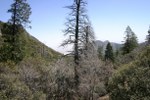 |
The Lutz Mine and the Pomona Mine of Southeastern Arizona |  |
 |
The Lutz Mine and the Pomona Mine of Southeastern Arizona |  |
The Coronado National Forest Hiking Guide for the Huachuca Mountains casually mentions the presence of mining equipment in Lutz Canyon, so I thought that I would take the two mile walk up the canyon to see what was there. The trail which was the old road to the Lutz mine is now in the Miller Peak Wilderness so there is no vehicular traffic.
I had taken a quick look on the Internet before leaving Tucson and had found out that a few test lots of ore were shipped in 1910 so I was expecting, at most, to see a bit of tin and other light duty pieces of iron when I got to the mine. It was a total surprise to find a large stationary engine and a very old compressor! The placement of the two pieces of equipment indicates that the engine and compressor were meant to be used in tandem.
I could not find any markings to indicate the builder of the engine. The compressor carries the markings of the Rand Drill Co. This company became Ingersol Rand in 1906 or so. The first Imperial Type 10 models were produced around 1902.
There is a tunnel next to the equipment and a larger working on the hillside above with a variety of rock samples showing the copper ore that was of interest scattered about.
Since I wanted to make my way to another mine in the area, I did not thoroughly investigate the site.
Click on photos to enlarge:
After leaving the Lutz Mine, I started a walk up to other mine that I had come to see. Before I got there, I came across a group of Border Patrol agents taking a break from a recent "chase".
They suggested that if I was up to a "hump" of a hike, that a better mine to walk to would be the Pomona Mine to the north. The implication was that there would be more equipment to see than the mine that I was headed for.
So a few days later, I went to check it out. The Pomona Mine, near the crest of the Huachucas, was an active mine over quite a few years. It produced a smorgasbord of metals, including Tungsten, Gold, Silver, Lead, Copper, and Zinc.
I parked at the end of the Brown Canyon Road to start my walk. I was too casual when I started walking and although I initially headed up canyon which was the direction to the mine, I soon realized that the trail that I was on was not the correct one. I should have gone down canyon to start and taken the old road. But rather than go back and start again, I followed a series of "illegal" trails cross-country back toward the mine. When I reached the canyon just south of the mine, there was a lot of old metal like engine parts, and truck beds that had washed or tumbled down so I turned to follow it upwards. I soon noticed an overhead cable and then a tower and I realized that I was looking at a tramway. I also could see the edge of the old road above me and so I climbed out of the canyon and decided I had to go to the crest. The road led to the upper workings, just below the top where I found an old modified engine and hoist combination, a large dump and several large cuts into the hillside. At this point, as I went to check my gps, I discovered that it had fallen out of the holster on my belt and was nowhere to be seen. My only choice was to try and re-trace my steps. A quarter mile or so down the hillside and below the road, I was so fortunate to spot it laying in the middle of a clear spot! Even though I was a bit tired, I told myself that I needed to climb back up to the road and then on to the very crest to see what was there. I was really curious to see what type of anchoring system was used for the tram line. The crest at 7000' is in the pines. There is an old cabin site with a lot of sheet metal, stove parts, metal barrels, etc. The tram line is anchored just below the crest with a series of truck axles driven into the bed rock.
The cable is still tight and suspended in the air. It was tensioned with a very large and heavy duty block and tackle system at the lower end. That end is anchored with axle spikes like those at the upper end. There are no "terminal" stations as often seen on tramways in other places. It is not clear to me how or if the tram was ever used. Near the lower end of the tram, is the old chassis of a vehicle with a nearly complete six cylinder engine. The engine is stamped " Silver Dome". Internet research shows that it was Chrysler made and first appeared in 1928 and lasted until at least the early '30's and was one tough engine. It would have had to have been if it powered the vehicle up the Pomona Mine Road. That is one steep road!
| Trips |
| Home |